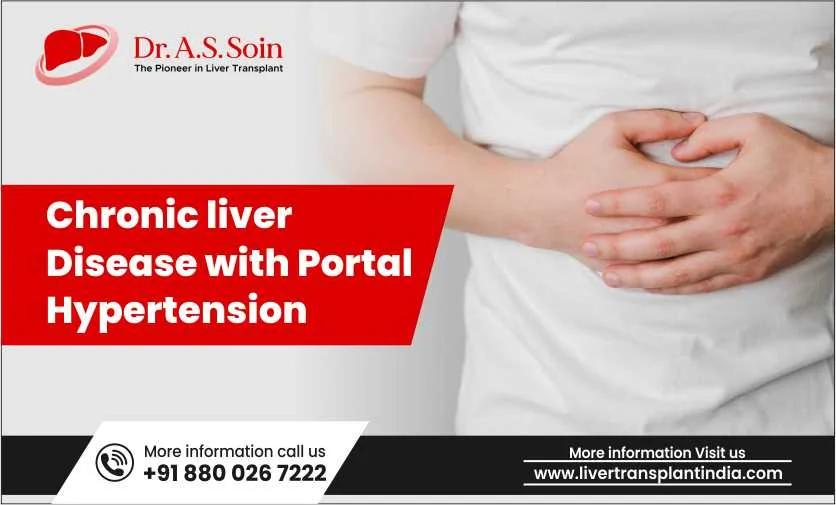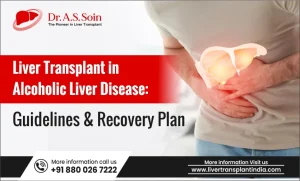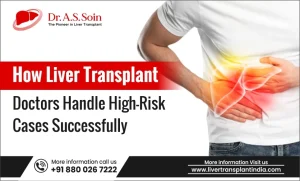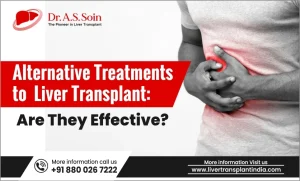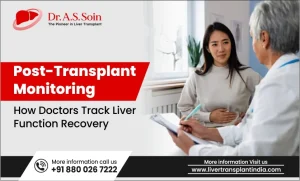Chronic liver disease doesn’t happen overnight. It evolves silently, often over years—sometimes decades. By the time patients start experiencing serious symptoms, one of the most common complications they face is something called portal hypertension.
But what does it really mean when someone has “chronic liver disease with portal hypertension”? Is it reversible? Can it be managed? Or is it time to talk about liver transplant?
Let’s take a closer look—layer by layer.
Table of Contents
ToggleWhat is Chronic Liver Disease (CLD)?
Chronic liver disease (CLD) refers to progressive, long-standing damage to the liver that persists for six months or more. Over time, healthy liver tissue is replaced by fibrotic (scarred) tissue. This scarring interrupts normal liver function, and when extensive, it leads to cirrhosis—a late-stage form of liver disease.
Some common causes of CLD are:
- Chronic viral hepatitis (especially Hepatitis B and C)
- Alcohol-related liver disease
- Non-alcoholic fatty liver disease (NAFLD) and its more severe form, NASH
- Autoimmune liver diseases
- Primary biliary cholangitis (PBC)
- Primary sclerosing cholangitis (PSC)
- Genetic/metabolic disorders (e.g., Wilson’s disease, hemochromatosis)
Whatever the cause, the end result is similar: the liver becomes inflamed, scarred, and less efficient at performing vital tasks like filtering toxins, processing nutrients, and producing essential proteins.
What Is Portal Hypertension?
Here’s where things get more specific.
Your liver receives about 75% of its blood supply through a vessel called the portal vein. This vein carries blood from the stomach, intestines, pancreas, and spleen straight to the liver for processing.
When chronic liver disease sets in and fibrosis builds up, the liver becomes stiff. The blood that once flowed freely through the portal vein can no longer pass easily. This leads to increased pressure within the portal vein—a condition called portal hypertension.
And once that begins, the body has no choice but to compensate—through dangerous shortcuts.
Why Does It Matter?
The body tries to compensate by forming collateral veins—new, alternative pathways to bypass the high-pressure zone. But these veins weren’t designed to handle high volumes or pressures.
The result?
Dangerous complications like:
- Esophageal or Gastric Varices
One of the most catastrophic complications. Dilated veins in the esophagus or stomach (varices) can rupture under pressure, leading to sudden upper GI bleeding. Mortality from variceal hemorrhage remains significant despite advances in endoscopic and pharmacologic therapy.
- Ascites
This refers to fluid buildup in the abdomen. High portal pressure and low protein levels from a dysfunctional liver combine to leak fluid from blood vessels into the abdominal cavity — it increases the risk of spontaneous bacterial peritonitis (SBP) and may affect kidney function.
- Enlarged Spleen (Splenomegaly)
Because the portal vein connects to the spleen, high pressure backs up into the spleen, causing it to swell. This can lead to a drop in platelets and white blood cells.
- Hepatic Encephalopathy
When the liver can no longer filter toxins, substances like ammonia build up and affect the brain. This results in confusion, drowsiness, or even coma.
- Caput Medusae and Visible Veins
You might notice dilated veins on the belly or around the navel, a sign that blood is being rerouted around a blocked liver.
- Hepatorenal Syndrome (HRS)
A functional kidney failure in the setting of portal hypertension and advanced cirrhosis — highly https://viceinvestigacion.utch.edu.co/ fatal without liver transplantation.
These complications aren’t just uncomfortable—they’re potentially life-threatening. And they almost always point to advanced liver disease.
But, Why Does Chronic Liver Disease Lead to Portal Hypertension?
This is rooted in basic physiology.https://khmldc.khm.gov.ua/
When liver tissue becomes fibrotic, the microscopic architecture of the liver—called sinusoids—gets distorted. These are the tiny channels where blood flows inside the liver.
The more scarring, the more resistance the blood faces. Over time, not only does the portal pressure rise, but the liver’s ability to detoxify the blood also drops. This double burden leads to toxin buildup and complications.
In essence, the liver becomes both a structural and functional bottleneck.
Signs and Symptoms
In the early stages, portal hypertension may not cause noticeable symptoms. It’s often detected during routine scans or endoscopies for CLD monitoring.
But once complications develop, signs become clear.
Common symptoms and signs include:
- Vomiting blood or black stools (a sign of variceal bleeding)
- Easy bruising or bleeding
- Increasing abdominal girth or discomfort (from ascites)
- Jaundice (yellowing of eyes and skin)
- Leg swelling
- Confusion or irritability
- Pruritis (itching)
- Fatigue and muscle wasting
- Enlarged spleen detected during physical examination
- Low platelet count in blood reports
A Doppler ultrasound or FibroScan can give your doctor early clues. But the gold standard for confirming portal hypertension is the hepatic venous http://www.masscomm.cus.ac.in/ pressure gradient (HVPG) measurement, done during specialized procedures.
How Is It Diagnosed?
Diagnosis is both clinical and investigative. A strong suspicion based on history (alcohol use, viral hepatitis, obesity) should prompt further evaluation.
https://ric2023.rcmrd.org/
Investigations include:
- Liver Function Tests (LFTs): Assess the extent of liver damage. It may show elevated bilirubin, ALT/AST, and low albumin.
- Complete Blood Count (CBC): Anemia, thrombocytopenia due to splenomegaly.
- Ultrasound Abdomen with Doppler: Checks liver texture, portal vein flow, and splenic size.
- Fibroscan or Transient Elastography: Non-invasive estimate of liver stiffness (a marker of fibrosis).
- Endoscopy: To assess for varices in the esophagus or stomach.
- MRI/CT Scan: For detailed liver architecture and complications.
- Hepatic venous pressure gradient (HVPG) measurement: In specialized centres, for exact portal pressure reading.
- Ascitic fluid analysis: If ascites is present, to rule out infection (SBP).
Can You Treat Portal Hypertension?
Yes—but the treatment isn’t always simple.
Medical Management
Here’s how targeted medicines help:
- Non-selective beta blockers are used to reduce the risk of variceal bleeding.
- Diuretics help control fluid retention (ascites).
- Lactulose and rifaximin are prescribed to reduce ammonia levels and prevent encephalopathy.
- Nutritional support and salt restriction become crucial.
Endoscopic Management
If a patient has esophageal varices, endoscopic variceal band ligation (EVBL) is performed to tie off high-risk veins and prevent bleeding.
Interventional Radiology
In selected cases, doctors may perform a TIPS (Transjugular Intrahepatic Portosystemic Shunt) procedure—a stent placed inside the liver to create a new low-resistance path for blood flow.
However, TIPS is not without risks. It can worsen hepatic encephalopathy and is generally reserved for specific cases.
What About Liver Transplant?
When portal hypertension reaches the point of recurrent bleeding, uncontrolled ascites, or liver failure, it’s time to consider liver transplantation.
https://job.meu.edu.jo/
In fact, many patients with portal hypertension are referred to transplant centers even before complete liver failure sets in—because the window for safe transplantation is narrow.
Under the care of experienced transplant specialists like Dr. A.S. Soin, patients undergo a thorough pre-transplant workup. This includes assessing liver function, varices, blood flow, kidney status, and overall fitness for surgery.
Is Portal Hypertension Always Irreversible?
Here’s the nuance.
https://epuo.acs.si/
Mild portal hypertension in non-cirrhotic liver disease can sometimes improve if the underlying cause is treated. For example, treating hepatitis C successfully can lead to fibrosis regression and improved portal flow.
However, in established cirrhosis with high HVPG values, the portal hypertension is mostly irreversible—unless liver transplantation is done.
That’s why early detection and intervention are vital.
Lifestyle and Monitoring
There’s a lot patients can do to slow the progression of CLD and manage portal hypertension effectively.
Here are some key recommendations:
- Avoid alcohol completely
- Maintain a healthy weight
- Limit salt intake (to reduce fluid retention)
- Eat a liver-friendly diet rich in protein (unless encephalopathy is present)
- Get regular monitoring including liver function tests, ultrasound, and endoscopy
- Avoid unnecessary painkillers and herbal medications that may damage the liver further
And most importantly—stay in regular follow-up with a hepatologist or liver transplant specialist.
Emotional and Financial Impact
Living with portal hypertension can be overwhelming—not just physically, but emotionally and financially too. Multiple hospital visits, endoscopies, blood transfusions, or fluid drainages can take a toll.
That’s why families need support—not just from doctors but also from counselors, social workers, and transplant teams who understand the journey.
At Dr. A.S. Soin’s liver practice, a dedicated multidisciplinary team works together to manage complex liver disease—supporting patients at every step, from diagnosis to long-term care and transplant planning when needed.
Prognosis: What to Expect Long-Term
The long-term outlook for someone with chronic liver disease and portal hypertension depends on several factors:
- The underlying cause of liver disease (alcohol, hepatitis, NASH, etc.)
- The degree of liver damage (compensated vs. decompensated cirrhosis)
- Presence of complications (like variceal bleeding or encephalopathy)
- Response to treatment and lifestyle changes
- Access to and timing of liver transplant
Patients with compensated cirrhosis (i.e., no major complications yet) may live many years with proper care and monitoring. However, once decompensation https://iu.indus.edu.pk/ sets in (ascites, bleeding, confusion), the 5-year survival drops significantly, sometimes below 50%, unless a transplant is done.
That’s why early recognition, active management, and timely referral to a transplant center are critical in improving prognosis and quality of life.
Final Words: What Patients (and Families) Must Know
Chronic liver disease with portal hypertension isn’t a straight line. Some patients remain stable for years. Others may decompensate quickly.
But with vigilant monitoring, timely interventions, and a clear plan—including the option of liver transplant when needed—we can still offer a life worth living.
https://www.semanadelpincho.es/
If you or your loved one has cirrhosis, don’t wait for the first bleed to act. Don’t ignore subtle signs like fatigue, leg swelling, or memory lapses. And above all—get under the care of a liver specialist early.
https://khentii.cfga.gov.mn/
Because in liver disease, time lost is liver lost.

